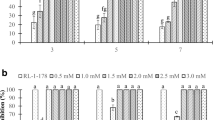Summary
The present work aims at the elucidation of the effect of either cotton dust and its components or 2,4-D on the relative vigours of the three pathogenic fungi namely,Fusarium solani, Sclerotium bataticola andBotrytis fabae. Botrytis mycelial growth was found to be comparatively more sensitive to cotton dust thanFusarium andSclerotium. The elucidation of the effect of individual cotton dust components has shown that Gammexane is the most effective inhibitory component while sulphur and DDT caused slight inhibition. This inhibitory effect of Gammexane is more pronounced when mixed with DDT than with sulphur. 500 p.p.m. 2,4-D concentration inhibitedBotrytis growth more thanFusarium orSclerotium, 1 % 2,4-D concentration was proved to be fungicidal. 2,4-D suppressed the germinative potentialities ofFusarium andBotrytis conidia.
Zusammenfassung
Die jetzige Arbeit trachtet nach der Aufklärung der Wirkung des Baumwollstaubes und seiner Bestandteile, und des 2,4-D auf die relative Widerstandsfähigkeit von drei pathogen Pilzen, nämlich,Fusarium solani, Sclerotium bataticola undBotrytis fabae. Mycelium-Wachstum vonBotrytis war vergleichsweise empfindlicher gegen Baumwollstaub als vonFusarium undSclerotium. Die Aufklärung der Wirkung der individuellen Komponenten des Baumwollstaubes zeigte, daß Gammexane der wirksamste, verzögernde Bestandteil ist, während Sulfur und DDT nur eine geringfügige Verzögerung verursachten. Die verzögernde Wirkung von Gammexane ist ausgesprochener, wenn es mit DDT als mit Sulfur gemischt ist. Die Konzentration von fünfhundert Teilen in 1 Million von 2,4-D unterdrückt das Wachstum vonBotrytis mehr als das vonFusarium oderSclerotium, die Konzentration von 1 % des 2,4-D war pilztötend. 2,4-D unterdrückte die Keimungsmöglichkeit vonFusarium undBotrytis Conidia.
Similar content being viewed by others
References
Bever, W. M. &Slife, F. W. (1948). The effect of 2,4-D. in culture medium on the growth of three pathogenic fungi; Phytopath.,38 1038.
Fleming, W. E. (1950). Persistence effect of DDT on Japanese beetle larvae in New Jersy soils; J. econ. Entom.,43 87–89.
Garber, H. H., Schaal, L. A. &Fults, Jess L. (1951) The selective action of penta chlorophenoxyacetic acid againstStreptomyces scabies (Thaxt.) Waksman & Henrici, in culture media: Phytopath.,41 991–996.
Guiscafre-Arrillaga, J. (1948) Sensitivity ofPenicillium digitatum to 2,4—Dichlorophenoxyacetic acid; Rev. appl. Mycol.,27 471.
Hsia, Y. T. &Christensen, J. J. (1951) Effect of 2,4-D on seedling blight of wheat caused byHelminthosporium sativum; Phytopath.41 1011–1020.
Ibrahim, I. A. (1951) Effect of 2,4-D on stem rust development in oats; Phytopath.,41 951–953.
Lewis, R. W. &Hammer, C. L. (1946) Effect of 2,4-D on some microorganisms: Mich. Agr. Expt. Sta. Quart. Bul.,29 112–114.
McFarland, W. H. (1946) The fungicidal properties of DDT; Rev. appl. Mycol.,25 589.
Peturson, B. (1951) Effect of growth promoting substances on the germination of uredospores of crown rust; Phytopath.,41 1039–1040.
Smith, M. S. (1948) Persistence of D.D.T. and benzene hexachloride in soils; Ann. appl. Biol.,35 494–504.
Steven, E. C. &Mitchell, J. W. (1945) Bacteriostatic and bacteriocidal properties of 2,4-D; Science,101 642.
Wei, C. T. &Ling, K. C. (1949) The effect of 2,4-D on spore germination of fungi; Rev. appl. Mycol.,28 70.
Wilson, J. K. &Choudhri, R. S. (1946) Effects of DDT on certain microbiological processes in the soil; J. econ. Entom.39 537.
Wilson, andWilson, K. &Choudhri, R. S. (1948) The effect of benzene hexachloride on soil organisms; J. agric. Res.77 25.
Author information
Authors and Affiliations
Rights and permissions
About this article
Cite this article
Mostafa, M.A., Gayed, S.K. A comparative study on the effect of cotton dust and 2, 4-D on three pathogenic fungi. Mycopathologia et Mycologia Applicata 13, 198–214 (1960). https://doi.org/10.1007/BF02089877
Issue Date:
DOI: https://doi.org/10.1007/BF02089877




